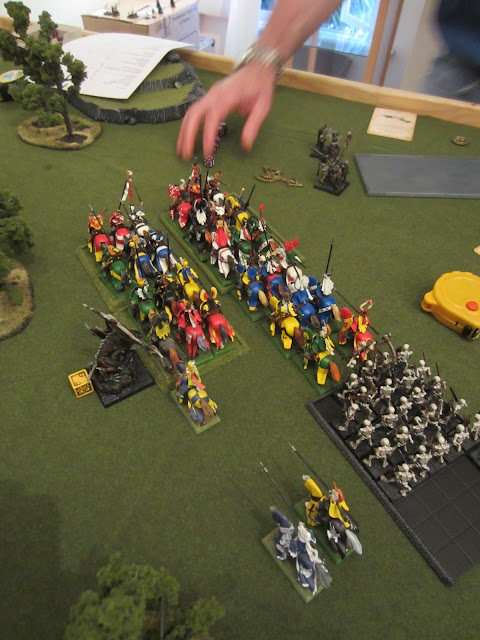The first game was a 1500 pointer against one of the Modest Modeler's Vampire Counts, who had defeated my Bretonnians in our first 8th Edition outing. We rolled up the 'Blood and Glory' scenario, which bases victory on the number of lost banners and slain generals. As I recall I had a slight advantage because ghouls don't have much use for banners (probably because they are inedible) while my Bretonnians pretty much insist that the only civilized way of killing something is under a rippling silken banner (more cinematic, you see).
DEPLOYMENT:
 In my last game my knights had been deployed too far apart to coordinate their charges effectively and got bogged down, so this time I tried grouping a large unit of knights of the realm (KoTR) with my general and a damsel and a large unit of knights errant (KE) on my right flank with my BSB. I lined up a horde (30 I think) of archers in the middle, and 24 men-at-arms with halberds on the right (just behind the trees). I took 5 mounted yeoman (truffle hunters!) and marched them up beyond the middle trees in a vanguard move. My general idea was to old up (at least a bit) the undead hordes with my peasant wretches and roll up the Vampire Count's line from right to left with a combined flank charge. The mounted yeomen on the far left were basically there to hold up the vargheist.
In my last game my knights had been deployed too far apart to coordinate their charges effectively and got bogged down, so this time I tried grouping a large unit of knights of the realm (KoTR) with my general and a damsel and a large unit of knights errant (KE) on my right flank with my BSB. I lined up a horde (30 I think) of archers in the middle, and 24 men-at-arms with halberds on the right (just behind the trees). I took 5 mounted yeoman (truffle hunters!) and marched them up beyond the middle trees in a vanguard move. My general idea was to old up (at least a bit) the undead hordes with my peasant wretches and roll up the Vampire Count's line from right to left with a combined flank charge. The mounted yeomen on the far left were basically there to hold up the vargheist.My opponent lined up three large blocks of living dead: from (MY) left to right there was a block of ghouls, a block of skeletons with hand weapons along with the terrifying red raged Vampire Lord general, and then a solid block of skeletal spearmen and a lesser (though still horrifying!) Vampire. The dreaded Vargheist was on my far left, behind the trees.
TURN 1:
In the face of unholy horrors, my devout Bretonnians dismounted and got out their prayer beads to invoke the Blessing of the Lady. The Vampire Counts took turn 1 and began their relentless advance, shuffling all units across the board.
Now things started to get more interesting... the Dread Vampire Lord lead his skeletons with unholy speed towards my terrified men-at-arms, and then charged! Cowardly curs that they are, the peasants turned and fled! The rest of the undead shuffled forward relentlessly.
If you look carefully you can see the vargheist emerging from the dark woods towards the back of the table (I told you he was there!) having ignored my pathetic truffle-hunting mounted yeoman for a bigger feast.
TURN 2
TURN 3
TURN 4(ish?):
Obviously the war-artist stopped painting to find a safer tree to hide in at this point because I missed out on some photos here... Basically the Vampire Lord and his skeletons made short work of my hapless peasant archers, running them down and claiming a second vital banner. He then reformed, ready to attack my knights in the rear.
The vargheist continued its advance, harassed at every step by my mounted yeomen. The hunters had brought the vargheist down to just one wound, and one well placed arrow would have ended the threat to my knights' flank, but twas sadly not to be.
My Bretonnian knights finally hacked their way through the skeletal spearmen, kicked their mighty chargers into a charge and smashed through the ghouls as well! A glimmer of hope for the servants of the Lady!
TURN 5:
Disaster! The Vampire Lord and his skeletons made an improbable charge straight into the rear of my KoTR. The vargheist hurtled into the flank of the KE.















